
The United States’ decision to postpone the “2+2” dialogue with India has led to a slew of comments about a “setback” and a “disconnect” in ties, with one going so far as to suggest this was done to force India to give the US “something”. While two postponements in the space of a few months is unusual, this is hardly an indication of significant differences between the two sides. The fact that the US Secretary of State personally spoke to the Indian External Affairs Minister to express “regret and deep disappointment” at having to cancel the dialogue suggests that it had to do more with the stated reason, scheduling conflicts, than with any deliberate signal of disagreement, let alone displeasure. It might, at worst, indicate carelessness. That is a problem, no doubt, but not as serious as a signal of disagreement on some issue between the two sides. What it indicates rather is that the US-India relationship is a high-maintenance one that requires constant work by both sides, part of which is dealing with the steady stream of imagined slights and grievances.
Partnership and alliances between democracies generally do require more maintenance because public opinion matters a lot more in democracies, making domestic politics an inherent element in alliance politics. The history of US alliances with other democracies demonstrates this amply.
This is not new or unusual. Partnership and alliances between democracies generally do require more maintenance because public opinion matters a lot more in democracies, making domestic politics an inherent element in alliance politics. The history of US alliances with other democracies demonstrates this amply. Whether it is the issue of the US bases in Okinawa in Japan, or French, German and Turkish opposition to the 2003 Iraq war, or many such other issues, domestic politics played an important role in at least the tone of US alliance politics, if not its fundamental substance. This works in reverse too, as the continuing controversy over the America’s Israel alliance shows, though this has not been as important in the US case until Trump started questioning the value of long-standing alliances.
Having said that, the US relationship has traditionally been much more troubled in India because of several additional factors. The US and India were on opposite sides of the Cold War divide and that history still rankles, especially in New Delhi. An additional reason is the post-colonial anti-Western sentiment that is deeply embedded in Indian foreign policy thinking and attitudes. A final factor is that India inherited, via its first prime minister, a British upper-class dismissiveness towards the US. None of this is new and many scholars have pointed this out in detail before (for example, here, and here). But the legacy of this strategic trait means that even after the US and India began building a strategic partnership, India was extremely sensitive about the nature of the relationship. India was the high-maintenance partner and the US has generally been much more careful and considerate. Under President Donald Trump, however, the US is proving to be equally high-maintenance, though this is today a common problem for all of Washington’s partners and allies.
The logic driving the US-India relationship should be clear — their mutual fear of the impact of China’s rise.
Much of the overwrought commentary in New Delhi is an indicator of India’s continuing ultra-sensitiveness. But much of it also misses the wood for the trees. The logic driving the US-India relationship should be clear — their mutual fear of the impact of China’s rise. It is nice that both India and the US are democracies and both have broad common interests about international order, rules and other such. They look good on diplomatic communiques but without the China-glue, they are pretty much useless. As obvious as this material imperative is, it still needs deliberate policy choices to be made. And in democracies, even these obvious choices are not always easy.
If New Delhi needs something to really worry about, it is the thick strain of American strategic thought that suggests that the US should withdraw from much of its global commitments and, a la Great Britain in the nineteenth century, and practice “off-shore balancing.” This is backed in part by growing wariness on both the Left and Right of the US political spectrum about the costs of US’s global commitments. Trump — and Obama before him — mainlined this sentiment. The real worry for New Delhi should be about the US losing interest in balancing China and cutting a deal with it instead.
In fairness, it should be noted that the much of the maintenance costs are imposed from outside the two governments. They may be constrained by it occasionally but both governments have generally been much sensible that the commentariat. The Indian government has generally been careful to talk its way through problems in the relationship; and even under Trump, the rest of the US administration has worked valiantly to maintain the long-term strategic objectives, even if they haven’t always succeeded. But both are democracies and that comes with some (acceptable) costs. Expect this to remain a high-maintenance relationship but as long as the China problem remains, expect also that both sides will work hard at it.
The views expressed above belong to the author(s). ORF research and analyses now available on Telegram! Click here to access our curated content — blogs, longforms and interviews.




 PREV
PREV


